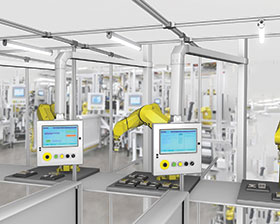

Saving money is an important consideration for most industrial users. Even if lighting does not account for a large share of the operating budget, every bit of savings helps the bottom line. Upgrading lighting can be an effective way to reduce facility and machine costs, while improving the productivity, safety, and functionality of a space.
Initial cost of lighting
The initial equipment cost for a lighting solution includes the housing, electrical equipment (e.g., the ballast or driver), and the light engine (e.g., the lamp or LED panel). Here, LED equipment is often more expensive than competing technology options, and the difference can be significant for certain applications.
Industrial users may also find that the initial cost of the lighting housing depends on the environment. As discussed below, some lighting can withstand the extreme conditions that are often present in industrial environments. These safeguards may increase the cost of the equipment, but the risk of damage or injury to people or other materials in the space is reduced, ultimately saving costs in the long run.
Industrial users should consider a redesign of the lighting system if any of the following situations apply:
• The existing lighting solution is in poor condition.
• The light distribution of the existing solution is uneven.
• The light distribution of the existing solution does not suit the use of the space e.g. if there have been changes in the design, components, furnishings, or conditions in the space.
• The desired illumination or distribution cannot be achieved with available retrofit options.
Operating costs
Small improvements in efficacy can result in significant operating cost savings over the lifetime of a lighting solution. Achieving appropriate levels of light for work areas by using focused task lighting can also add to the savings.
Efficacy ratings vary significantly among different technologies and applications, from less than 15 lumens per watt (lm/W) for standard 60 W incandescent lamps, to 150 lm/W for the latest LED area lighting. Generally, lights with higher lumen outputs have higher efficacy ratings. LEDs often have better efficacy than other technologies, but highly efficient fluorescent and HID options can provide better or similar efficacies for some applications. Reducing the lighting system’s power will also save on demand charges. When commercial or industrial customers significantly reduce their power draw, they should review their utility rates schedules to determine which schedule is most economically attractive.
Maintenance costs
Industrial users should understand the maintenance costs associated with a lighting solution. Having a plan in place for routinely replacing lamps and cleaning surfaces can reduce the total amount of labour needed for maintenance.
The performance of any lighting solution will deteriorate over time through the failure of lamps, ballasts, or drivers; gradual lumen depreciation and colour shift. To plan effectively, it is important to attempt to predict the lifetime of a given technology and understand how and when the lighting system will likely deteriorate. LED technology is treated differently in this regard. LED chips degrade slowly over time, producing less light and shifting their colour characteristics. The metric used to define the lifetime of LEDs is L70 lumen maintenance. This refers to the amount of time the LED will operate while maintaining at least 70% of initial output. Some LEDs will take longer to get down to 70%.
The projected L70 value for LEDs can exceed 50 000 hours. In addition, the LED chips often last longer than the drivers that power them, which means that industrial users may need to replace drivers before the light engine.
Cost of ownership
When considering lighting costs, industrial users should recognise that the initial cost is only part of the life-cycle cost of the lighting solution. Maintenance and replacement costs depend on the lifetime of the equipment, and the energy costs depend on the equipment’s efficiency. For this reason, longer-lasting and more efficient technologies can produce significant savings, even if they are initially more expensive.
LED fixtures can have higher initial costs for a given application than other technologies. However, they are often also the most efficient option available and have the longest lifetime. Some industrial users may find fluorescent or HID technology better suited to their needs, but that may not be the case for much longer given the rapid pace of advancements in LED technology.
For more information contact Brandon Topham, RET Automation Controls, +27 (0)11 453 2468, [email protected], www.retautomation.com
| Tel: | +27 11 453 2468 |
| Email: | [email protected] |
| www: | www.turckbanner.co.za |
| Articles: | More information and articles about Turck Banner Southern Africa |

© Technews Publishing (Pty) Ltd | All Rights Reserved